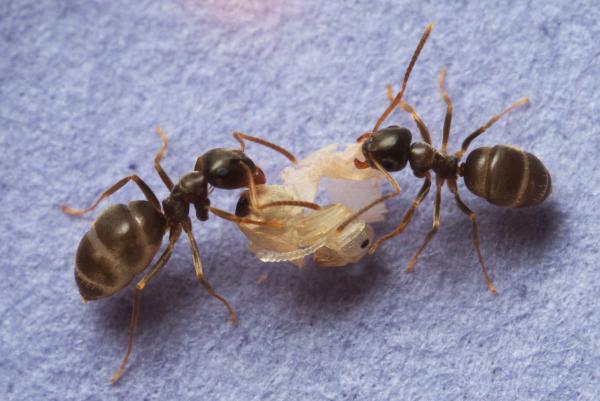
The flu reminds us that humans, as social creatures, are more susceptible to contagious disease than more solitary species. But do other social species treat contagion differently and could there be evolutionary insights to discover? A study of ants published in eLife reveals a somewhat different approach when infection threatens their society.
The Study
Researchers exposed an immobile community of garden ants to a fungus known to infect them. Typically, the fungus is brought in from outside the brood on the cuticle (skin) of the ants. At this point, the ant is merely contaminated; but shortly after that, the fungus breaks through the cuticle, infecting the ant. Following a brief incubation, the host ant dies releasing many more fungi to contaminate and infect neighboring ants. The ant's first defense is social. Much like we would wash our hands with soap and water, ants groom or mechanically removing fungus found on their contaminated companions and then sprayed formic acid, the ant’s go-to “poison,” on the cuticle to further disinfect the tainted ants. The researchers were interested in the behavior of the ants when simple decontamination was insufficient; how did the ants manage their infected brethren?
The researchers exposed ant pupae to a fungus. They knew from a prior study that these contaminated pupae were frequently removed from the brood, a behavior they termed unpacking. In their first experiment they found that a majority (85%) of these unpacked ants were not only contaminated but infected; in comparison, only 25% of contaminated but unpacked ants were infected. Ants could differentiate contaminated from the more deadly infected ants. But the work of both the researchers and ants continued.
The exposed and now unpacked pupae were groomed mechanically removing any fungus on the outside of their cuticle. To this point, it was that same initial "social" defense. But these pupae got a much more severe formic acid disinfection. Their cuticles were sprayed 15 times more than ants that were merely contaminated. And then, for good measure, the cuticle was breached by tiny bites from the groomers who then proceeded to spray more formic acid inside the pupae – leaving dead pupae with a heavily damaged corpse. The authors termed this behavior, destructive disinfection.
Destructive disinfection may be a radical treatment (especially for the recipient pupae), but it is effective. Continued disinfection over a day or two reduces infected pupae by 95%. And in their study, destructive disinfection resulted in no transmission to other ants versus a 42% transmission when disinfection did not occur.
Ants identified alterations in the scent of infected pupae. The authors presented evidence that the altered smell was due to chemicals released by the immune response not the presence of the fungus itself. So, they concluded that ants manage contagion in a staged manner, grooming, isolating and destroying as the threat increases from contamination to contagion; making these choices even before the contagion is readily apparent.
Musings
Are there lessons for us? Social animals detect disease in a companion through a variety of means. It may be visually apparent through rashes or a sallow appearance; or abnormal behavior, like arguing with yourself in the middle of the street; or like ants, there may be changes in scents, as dogs can identify when their owners are ill. There is also good evidence that we respond initially by trying to interact less or completely avoid the “diseased” altogether - consider again, that one person arguing with invisible people. Other evidence suggests that our immune system begins to pre-prepare when exposed to contaminated "others." At the same time, the social response by diseased individuals may be to hide their symptoms. Part of the reason for the early spread of HIV was the hiding of symptoms from others.
Our social response to illness, the shunning and hiding as well as the grooming and disinfection (a metaphor for our health systems) reflect priorities. Exclusion protects the crowd at the expense of the individual; hiding disease promotes the individual at the expense of contagion for society.
The study demonstrates what the researchers called a care-kill dichotomy. Ants groom their contaminated colleagues, a social form of immunity where the needs of the colony and individual ant are aligned. But in the presence of infection, the individual is killed, favoring the colony over the easily replaced worker - when goals are unaligned, the colony wins.
The ants have made a choice; individuals are rapidly killed to protect the brood and eliminate contagion. But we are not ants, well except we are in at least one way. Ants are societies with a strict division, a reproducing queen, and non-reproducing but supportive workers. They must act together, or they will not survive; forming a “superorganism” where the whole is greater than the parts. Humans are superorganisms too, with eggs and sperm for reproduction and the rest of our many varied cells providing support, as interdependent as the ant colony.
Is it possible that the same evolutionary forces that shaped the response of ants, formed our immune response? Our pathogens are frequently met by mechanical defenses initially; the skin is a significant protective barrier, and the cells lining our lungs secrete mucous that traps the contaminants we breathe.
Those pathogens circumventing these mechanical measures become targets for our innate immune system, a system that can identify the invaders and remove them, frequently by creating pores in their membranes, holes in their defenses, and attack them with cellular poisons. The lost cells, neutrophils, are easily sacrificed for the good of the whole, you and me.
It seems that nature’s position is that the individual good should be subservient to that of the community.
Source: Destructive disinfection of infected brood prevents systemic disease spread in ant colonies eLife 2018 DOI:10.7554/elife.32073



